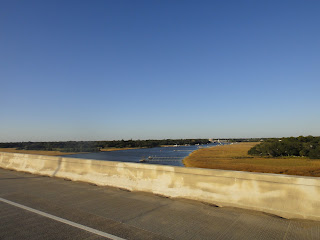 This is the Arthur Ravenel, Jr. Bridge in my hometown of Charleston, SC. With its twin 575-foot diamond towers, quarter mile span, eight lanes of traffic, and separated pedestrian lane that offers breathtaking views of the Holy City and its waterways, the 2.5-mile "Ravenel Bridge" is a marvel of civil engineering. Other than the fact that it's visually impressive, this bridge is unique in that it's a fixture of highway infrastructure that isn't painted white. The designers of the Ravenel Bridge chose to leave its concrete its natural color for two reasons: 1) white paint would increase the contrast between the taller, modern-looking towers and the lower, historic Charleston skyline; 2) the massive size of the bridge would make painting a major undertaking.
This is the Arthur Ravenel, Jr. Bridge in my hometown of Charleston, SC. With its twin 575-foot diamond towers, quarter mile span, eight lanes of traffic, and separated pedestrian lane that offers breathtaking views of the Holy City and its waterways, the 2.5-mile "Ravenel Bridge" is a marvel of civil engineering. Other than the fact that it's visually impressive, this bridge is unique in that it's a fixture of highway infrastructure that isn't painted white. The designers of the Ravenel Bridge chose to leave its concrete its natural color for two reasons: 1) white paint would increase the contrast between the taller, modern-looking towers and the lower, historic Charleston skyline; 2) the massive size of the bridge would make painting a major undertaking. This is the Robert B. Scarborough Bridge in Charleston. Although not as visually-impressive as the Ravenel Bridge, the 3-mile "James Island Connector" also offers excellent views of the Holy City and its waterways. Other than being smaller and less visually-stimulating, this bridge differs from the Ravenel Bridge in that it's painted standard "freeway white".
This is the Robert B. Scarborough Bridge in Charleston. Although not as visually-impressive as the Ravenel Bridge, the 3-mile "James Island Connector" also offers excellent views of the Holy City and its waterways. Other than being smaller and less visually-stimulating, this bridge differs from the Ravenel Bridge in that it's painted standard "freeway white". Let's compare the concrete from the Ravenel Bridge and the James Island Connector:
 |
| Ravenel Bridge |
 |
| James Island Connector |
Notice that the latter is marred by a "Jackson Pollock" pattern of fading paint. Now consider this: If its concrete had been left its natural color (as is the case with the Ravenel Bridge), the James Island Connector would have cost millions less. In other words, taxpayers spent millions of dollars for no reason but to blemish what should be pristine views of my hometown.
Seth Mason, Charleston SC
